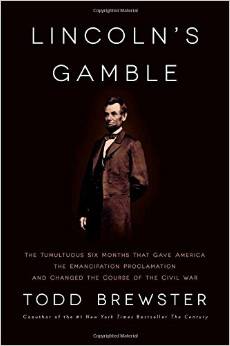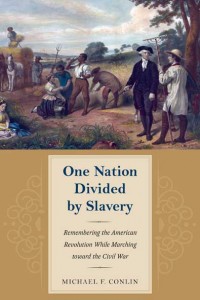Lincoln’s Gamble: The Tumultuous Six Months That Gave America the Emancipation Proclamation and Changed the Course of the Civil War by Todd Brewster. Scribner, 2014. Cloth, IBSN: 978-1451693867. $27.00.
 “I love him not because he was perfect but because he was not and yet triumphed.” So proclaimed W.E.B. DuBois in 1922 in an oft-quoted passage on Abraham Lincoln. DuBois revealed his fear that people had lost sight of the “real man,” with all of his inconsistencies. Todd Brewster, a veteran journalist and producer, has fashioned DuBois’ reflection into a research question: can a “hinge moment,” a critical six-month period, provide “a target for discovering the real Lincoln”? (8). The result is Lincoln’s Gamble: The Tumultuous Six Months That Gave America the Emancipation Proclamation and Changed the Course of the Civil War, a well-written and interesting investigation into Lincoln’s world during the second half of 1862.
“I love him not because he was perfect but because he was not and yet triumphed.” So proclaimed W.E.B. DuBois in 1922 in an oft-quoted passage on Abraham Lincoln. DuBois revealed his fear that people had lost sight of the “real man,” with all of his inconsistencies. Todd Brewster, a veteran journalist and producer, has fashioned DuBois’ reflection into a research question: can a “hinge moment,” a critical six-month period, provide “a target for discovering the real Lincoln”? (8). The result is Lincoln’s Gamble: The Tumultuous Six Months That Gave America the Emancipation Proclamation and Changed the Course of the Civil War, a well-written and interesting investigation into Lincoln’s world during the second half of 1862.
The book unfolds in narrative fashion, moving Lincoln from his first discussions of emancipation with cabinet members on July 13, 1862, through the issuance of the Emancipation Proclamation on January 1, 1863. While that act overshadows the entire period, Brewster is at pains to show all of the other events and issues that demanded Lincoln’s time and attention during those six months. At the same time, this book covers much more territory than just late 1862, with Brewster often using a particular incident to go back in time to show how Lincoln’s earlier experiences shaped him, or to offer similar vignettes for those with whom Lincoln interacted. Thus, one of the strengths of the book is the extent to which Brewster provides the reader with the context and background necessary to understand the players and events of 1862.
The first chapter of Lincoln’s Gamble is emblematic of this context-rich approach. Brewster begins with Lincoln telling cabinet members William Seward and Gideon Welles that he was ready to free the slaves (27). Throughout the chapter, Brewster provides extensive biographies of Seward and Welles, including their stances on slavery and how they came to serve in Lincoln’s cabinet. He also explains the status of the war in the summer of 1862, highlighted by George McClellan’s follies during the Peninsula Campaign.
In some cases, the context ranges farther afield. In the third chapter, a mention of Lincoln’s use of the telegraph office as a workspace leads to four pages on Samuel Morse and the invention of that technology, while a discussion on Lincoln’s and Bates’ views on miscegenation includes a reference to the 1967 Supreme Court case Loving v. Virginia. In some cases, there is an overabundance of context, but in others it proves invaluable. In a chapter titled “Send Them Away,” Brewster discusses Lincoln’s support for colonization as a way to remove former slaves from the United States—and thus allay the concerns of those northern citizens who desired an end to slavery, but did not want to live next to or compete with freedmen for jobs. Brewster lays out the history of African-American colonization, including the support that Henry Clay lent the concept. Citing Clay’s influence on Lincoln, Brewster uses this context to show where much of Lincoln’s thinking about colonization likely originated.
In emancipation historiography, views range widely—from those who interpret Lincoln as a fundamental racist who only proclaimed emancipation as a war measure to save the Union, to those who believe that he was a closet abolitionist waiting for an opportunity to strike against the peculiar institution. Brewster falls somewhere in the middle, but closer to the former than the latter. Early on, he notes “Lincoln’s painful ambivalence toward emancipation,” and that he was “uncomfortable with any plan that did not take gradualism as its philosophy and popular consensus as its partner” (46). In a chapter that discusses Lincoln’s meeting with a black delegation on August 14, 1862, when Lincoln pushed colonization and expressed his doubts that the two races could ever live together, Brewster closes simply by quoting from Lincoln’s letter to newspaper editor Horace Greeley, in which the president asserted, “What I do about slavery, and the colored race, I do because I believe it helps to save the Union” (106). Brewster notes that in the cabinet meeting immediately following the issuance of the preliminary emancipation proclamation on September 22, 1862, Lincoln argued for colonization, suggesting that the act was not intended as a step toward eventual abolition but as one purely designed to restore the Union (166). Finally, on the last page Brewster concludes, “The Emancipation Proclamation… led to the establishment of ‘equality’—a notion that Lincoln had resisted, at least in its full-blown form” (250).
This book occupies an interesting space. It is not a straightforward monograph that puts forth a new argument to challenge the Lincoln historiography. In some ways, it reads as a biography of Lincoln: one that is focused on a particular six-month stretch of his life rather than its entirety. But Brewster’s interjection of a line or two of his own voice makes the book read as a journey of discovery: one in which the reader is a participant. This approach, combined with Brewster’s pleasant writing style, makes Lincoln’s Gamble an excellent entre into this particular “hinge moment.”
Jared Peatman is the author of The Long Shadow of Lincoln’s Gettysburg Address (2013).
